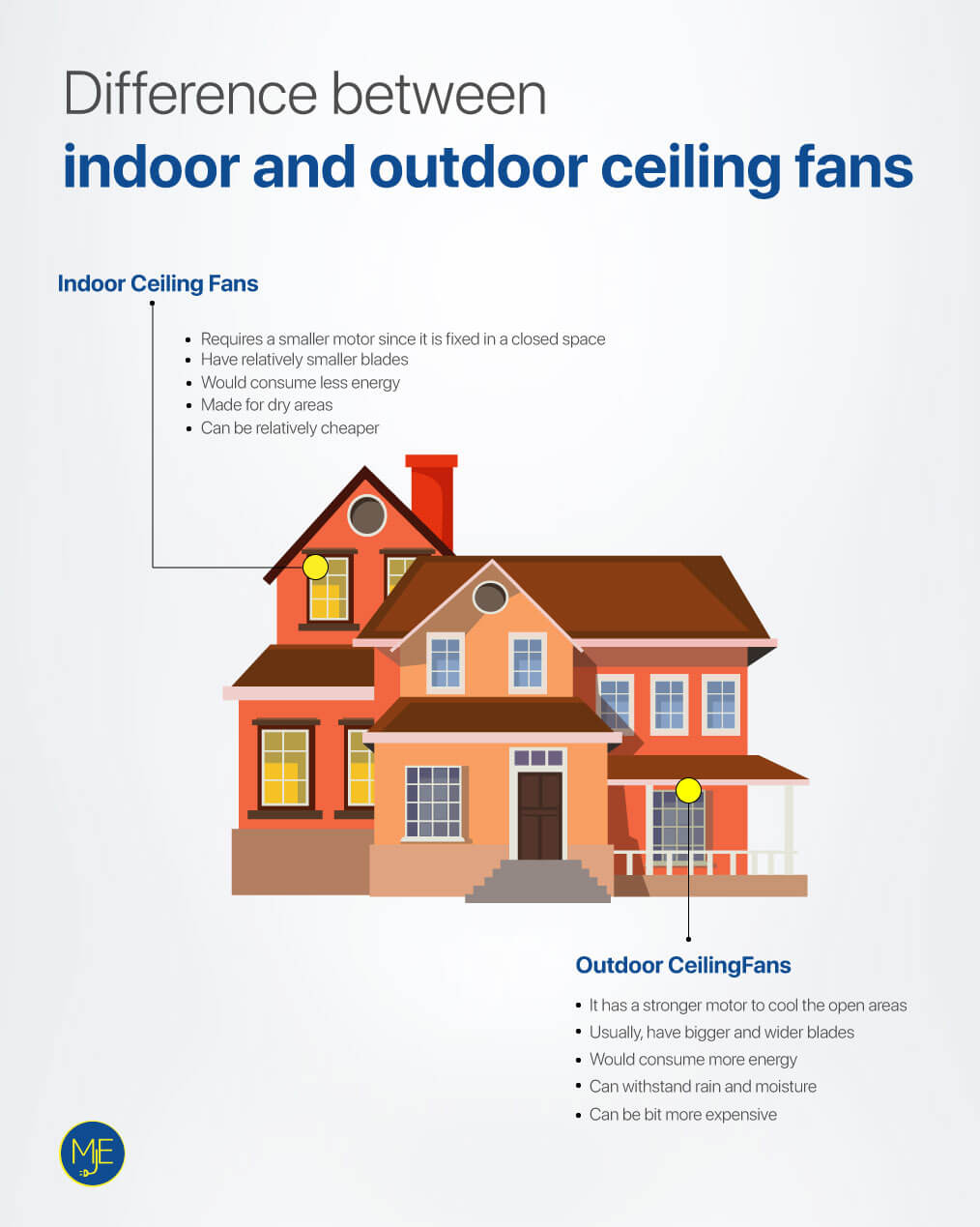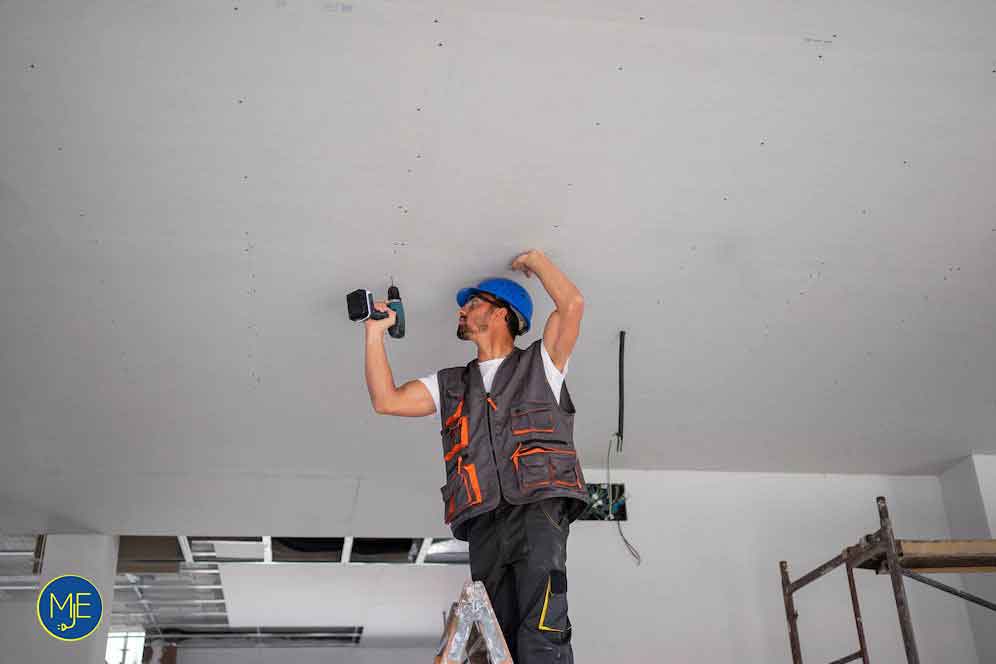Did you know that there are indoor and outdoor ceiling fans in the market? Yes, there are both indoor and outdoor fans available. However, there are some key differences between indoor and outdoor ceiling fans. This article will explore those differences and provide insights on choosing the right fan for your needs. Additionally, we will discuss the importance of professional ceiling fan installation.
If you plan to install a ceiling fan, you should know the difference between these two types of ceiling fans. Read this article till the end to get a helpful insight into both types of fans.
Is there a difference between indoor and outdoor ceiling fans?
You might think all ceiling fans are the same and suitable for any location. Well, it’s not true. It is not a marketing trick, and there is a difference between indoor and outdoor ceiling fans.
While there are various differences between these two fans, the main difference is the materials from which they are made out of. Outdoor ceiling fans are made out of a strong material that can withstand heavy wind and rain.
However, indoor fans are not made to withstand these changes in climatic conditions. They are not suitable when there is high moisture and wind.
Here are some of the other differences between indoor and outdoor ceiling fans.
Outdoor ceiling fans | Indoor ceiling fans |
It has a stronger motor to cool the open areas | Requires a smaller motor since it is fixed in a closed space |
Usually have bigger and wider blades | Have relatively smaller blades |
Would consume more energy | Would consume less energy |
Can withstand rain and moisture | Made for dry areas |
Can be bit more expensive | Can be relatively cheaper |

What are the different types of ceiling fans in the market?
Now you know the differences between both indoor and outdoor ceiling fans. Accordingly, the ceiling fans are rated and categorised into three types.
1. Dry-rated
The dry-rated fans are only suitable for dry areas. Therefore, you should fix them in enclosed locations. These fans are made out of materials such as plastic and wood. Therefore they cannot withstand moisture.
These fans would rust and get damaged if they were exposed to moisture. Since these fans have no environmental constraints, manufacturers have added various electronic options and attractive designs.
2. Damp-rated
The damp-rated fans can withstand the moisture in the air. These fans are made with moisture-resistant materials. Further, their motors and wirings are sealed to protect them from moisture. Therefore you can fix these fans indoors and outdoors where there is moisture.
Although the damp-rated fans are resistant to moisture, they can get damaged by direct contact with water. Therefore they are not suitable for open areas which are affected by snow and rain. However, these fans are suitable for outdoor spaces such as garages, covered patios, porches, etc.
You can mount these fans in indoor spaces such as laundries, kitchens, bathrooms, etc. These fans have fewer electronic features and have design constraints.
3. Wet-rated
The wet-rated fans are the best option for open outdoor areas since they are resistant to rain and snow. The wet-rated fans are made with water-resistant materials such as high-quality plastic and marine-grade metal.
These fans don’t get rusted due to water and moisture. They can also withstand heavy winds. The fans’ motor and wires are perfectly sealed to protect them from water.
The best thing about these fans is they are much easier to clean and maintain. You can use a hose and flush the fans.
Dry rated | Damp rated | Wet rated |
Not wind-proof. | Not much wind-proof. | Designed to withstand heavy winds. |
Suitable for dry areas such as living rooms, bedrooms, etc. | Suitable for areas with moisture, such as kitchens, bathrooms, laundries, etc. | Suitable for every location, including wet outdoor areas. |
Made out of a variety of materials. | Made out of moisture-proof materials. | Made out of water-resistant and strong material. |
Harder to clean. | A bit harder to clean. | Easy to clean. |
It comes with more electronic features. | Less electronic features. | Minimal electronic features.
|
It comes in a variety of designs and plenty of options. | A large variety of options and brands. | Minimal number of options and brands. |
Are outdoor ceiling fans water-proof?
As you can see from the above table, you can use both damp-rated and wet-rated ceiling fans outside. However, damp-rated fans are not waterproof. They can withstand moisture but are not water-proof.
If you want waterproof outdoor ceiling fans, then you should select wet-rated fans.
Can I use an outdoor ceiling fan indoors?
Now that you know the different ratings of ceiling fans, it is time to find out whether you could use outdoor ceiling fans inside.
In simple, yes, you can use outdoor ceiling fans inside. Both damp-rated and wet-rated fans are already moisture-proof and inherently suitable for dry areas. Because of their design, many people use outdoor ceiling fans on the inside. If it matches their interior design, they will buy it.
Are outdoor fans more suitable for indoors than indoor fans?

As discussed earlier, we could fix outdoor fans indoors. However, are they the most suitable? If so, why are there dry-rated fans?
Let’s keep the facts simple. We can fix outdoor fans on the inside, but it might not be the best choice. Why?
- Outdoor fans are water-protected, have a high-capacity motor, and have strong blades. Therefore they can be a bit more expensive. Sometimes, they might even consume more electricity.
- There are minimal design options and electronic features. Therefore you might miss the modern technology and designs if you choose outdoor fans.
- Indoor fans are comparatively easy to repair.
Therefore indoor fans are more suitable for indoors than outdoor fans. Don’t think that all fans are the same.
Why shouldn’t you use indoor ceiling fans outside?
As you know, the indoor fans are dry-rated. They cannot withstand moisture and water. Therefore fixing these fans on the outside can damage them. These fans could get rusted with moisture.
On the other hand, the motor and wiring in these fans are not appropriately sealed. Therefore if the moisture or water leaks inside, it could cause electrical shortages, leading to fire hazards.
As a result, you should not fix indoor fans on the outside since it can be hazardous.
What is the best ceiling fan size for outdoors?
There are various outdoor fans in the market with different sizes or capacities. The capacity or the size of a fan is measured by Cubic Feet per Minute (CFM).
The required fan capacity for your area will depend on various factors.
- The area of the space that the fan needs to cool.
- The nature of the location in which you will mount the ceiling fan.
- How many ceiling fans would you mount?
Therefore the required ceiling fan capacity would differ from one job to another. Therefore, getting an expert’s opinion is ideal before purchasing a fan.
What are the best outdoor ceiling fans?
There are various kinds of outdoor ceiling fans in the market. Here are some of the most popular and best outdoor ceiling fans in Australia.
- Aqua DC ceiling fans
- Fanco eco silent deluxe DC
- Airborne Storm DC
- Fanco Horizon DC
- Fanco Sanctuary DC
- Origin DC
How to install an outdoor ceiling fan?

Installing an outdoor ceiling fan can be quite tricky. You should find the optimum location and decide the optimum distance from the ground to place the fan.
The outdoor ceiling fans will be subjected to heavy winds. Therefore it should be placed correctly and supported with a solid brace to withstand heavy winds.
Further, the wiring should be done accurately. It should be protected from moisture and water. Otherwise, there can be risks of fire hazards. Therefore, fixing an outdoor ceiling fan can be more complex than fixing an indoor one.
As a result, it is ideal to hire an electrician for the job. It will keep you away from electrical hazards. Further, it is also illegal to do any electrical work in Victoria without the required licenses and qualifications. So don’t try to do it yourself if you are not qualified.
Summary
There is a clear difference between both indoor and outdoor ceiling fans. Accordingly, the ceiling fans are categorised into three as per the UL rating. These types are dry-rated, damp-rated, and wet-rated.
The dry-rated fans are suitable for indoors only. However, we can use damp and wet-rated fans indoors and outdoors. You should also remember that you cannot use damp-rated fans in open areas that are directly exposed to water or snow.
You should not use indoor ceiling fans on the outside, but you could use outdoor ceiling fans on the inside. However, it is always better to stick to the basics and only use indoor fans on the inside instead of outdoor fans.
Fixing an outdoor ceiling fan can be quite tricky. Therefore you should seek the service of a skilled electrician. If you are looking for an electrician in Ballarat, don’t hesitate to contact MJ Electrician.
We have served the Ballarat community for many years and hold the required licenses and expertise to help you.





